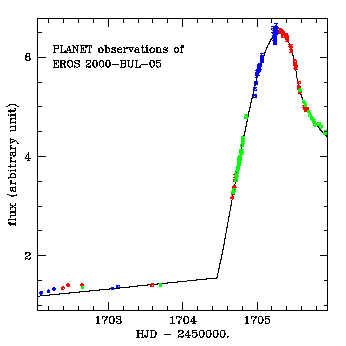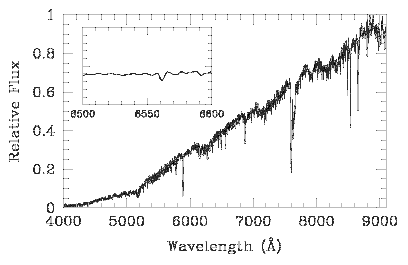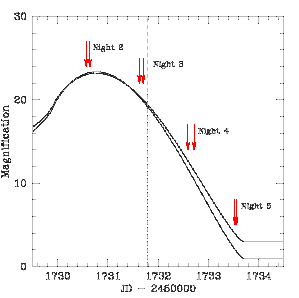|
Left: Two lensing stars of equal mass (two black dots)
create a caustic structure --- regions where the combined effect of both
lenses is enormous (solid black line).
Right: The light curves of sources passing over this
caustic structure exhibit sharp peaks in brightness
at the moment of crossing. The exact light curve shape depends
on the source path (colored lines in the left-hand figure)
and the mass and separation of the lenses.
(Adapted from Paczynski 1996.)
|
When a background star crosses a caustic, a large peak is produced in its
light curve, and the portions of the star directly over the caustic are
magnified more than the rest of the star. Microlensing caustics can
thus be used to magnify and
resolve the
the face of a very distant star.
The Unusual Microlensing Event EROS BLG-2000-5
International collaborations of astronomers watch millions of stars nightly
to search for microlensing events.
On 5 May 2000, Jean-Francois Glicenstein of the EROS group
alerted astronomers to
an apparently normal microlensing event in the direction of the
Galactic Bulge. Since the event, named
EROS BLG-2000-5, was rising in brightness,
the PLANET team
began to monitor it intensively,
as part of its regular operations to search
for brief anomalies that might be indicative of lensing
Jupiter-mass planets.
The MPS team was also watching this event, and on 8 June 2000 they
issued an alert that the source star was undergoing an unusual brightening.
PLANET observers immediately
turned their full attention to this event, monitoring it nearly continously
from five different observing sites for the weeks to come.
 It was soon clear that EROS BLG-2000-5 was due to a binary lens.
The sudden jump in the
light curve on June 8 was tracked by PLANET. These data, together with
real-time modeling, allowed the team to issue an
electronic alert that included precise timing (to within 3 minutes)
and characterization of the first caustic crossing. A second
crossing could then be expected with a few days or weeks.
It was soon clear that EROS BLG-2000-5 was due to a binary lens.
The sudden jump in the
light curve on June 8 was tracked by PLANET. These data, together with
real-time modeling, allowed the team to issue an
electronic alert that included precise timing (to within 3 minutes)
and characterization of the first caustic crossing. A second
crossing could then be expected with a few days or weeks.
While the light curve of the event indicated that the source was
in the ``caustic trough'' between the first and second crossings,
the PLANET team applied for Director's Discretionary Time
on the
Very Large Telescope (VLT) at the
European Southern Observatory (ESO) on
Paranal in Chile
to monitor the
spectrum of the event during the second caustic crossing.
Meanwhile, the team continued to monitor EROS BLG-2000-5
from their network of small, southern telescopes and to issue
(second,
third)
public information about when the second crossing
might be expected.
The Results from the Very Large Telescope
Within a few days, the request for VLT time was granted. Spectra would be
taken with the FORS
spectrograph on the first unit telescope, named Antu. The plan for the
observations would be executed remotely, with service astronomers at ESO
responsible for manipulating the telescope.

Spectra taken on 25 June 2000 when the event was highly magnified,
but had not yet crossed the caustic for the second time, indicated a
large flux at red wavelengths
(9000 angstroms)
compared to blue
wavelengths (4000 angstroms).
Absorption line strengths could be measured,
such as the small dip at 6563 angstroms (the H-alpha line) caused by hydrogen
atoms in the outer atmosphere absorbing light produced deeper
in the star.
The FORS spectra
indicated clearly that EROS-BLG-2000-5
was a cool, K giant star.

The FORS instrument
takes images as well as spectra. In only 0.25 seconds of
exposure time, the 8-meter diameter mirror of the VLT aided FORS in taking the
image shown at right (2 arcminutes on a side).
EROS-BLG-2000-5 is circled in red, and
was already highly magnified at this point in time.
The long opening slit of FORS was aligned with other stars in the field.
In this way,
changes in the spectrum of the EROS-BLG-2000-5 source star could be
compared to the spectrum of other stars (which shouldn't be varying!),
providing a useful check in the experiment.
The team continued to monitor the event. Modeling by PLANET team members at Ohio
State University was somewhat uncertain, but clearly indicated that the
second crossing would be long, lasting
several days rather than the usual 10-20 hours.

So the observing plan
was altered so that spectra could be taken on four nights
(see figure at left) during the caustic crossing, when the light curve would be
brightening, and then dimming dramatically as the source finally
exited the caustic. Due to
limb darkening,
the cooler, outer regions of a star appear dimmer and redder than the center.
Over the four nights of the crossing, the source would be moving
across the caustic: first the cooler leading edge (limb) of the star would
cross, then the hotter middle, and finally the trailing limb.
Changes in the brightness and color across the face of a few microlensed stars
had already been measured during caustic crossings. The PLANET team
now expected to see changes in the strength of the absorption lines,
which are determined by the
temperatures
in the stellar atmosphere, as well. This effect should be visible in the FORS spectra.
On the nights beginning 4, 5, 6 and 7 July 2000, the ESO service observers executed
the last steps of the PLANET team plan; close contact was maintained via email
and the Internet.
Every night while the source star was nearly directly overhead in Chilean skies,
the FORS spectrograph measured the spectral content of the light coming from
EROS-BLG-2000-5.
When the results were reduced, and analyzed by two different PLANET team
members in two different ways, the results were the same: the strength of
the H-alpha absorption line in EROS-BLG-2000-5
changed systematically throughout the second caustic crossing, the line strength
of the control stars varied only slightly or not at all.

About 40 red spectra were taken in all.
When the strength (or
equivalent width, EW)
of the H-alpha line was plotted
as a function of time, the strength became stronger as the center of
the star passed over the caustic, and then much weaker as the trailing
limb exited the caustic. The measurements are shown as black dots in the
figure at right; the red dots are the average strength of the absorption
line on each of the five nights, one before the second crossing on 25 June,
and one each for the four nights of the caustic crossing.
Stellar atmosphere specialist Peter Hauschildt of the University of Georgia
prepared special models of K giant atmospheres that could be compared to these
results. These models include the effects of hundreds of thousands of possible
chemical transitions in the atmosphere of the cool giant star, each of which
can affect, to a larger or smaller degree, the observed stellar spectrum.
When PLANET team members simulated the effects of a simple caustic
crossing passing over these theoretical stars, they obtained the solid lines
shown in the plot above. The models
(and thus the assumed chemistry of cool K giant
star atmospheres)
clearly match these observations in their general form.
What's Next?
But do the VLT observations of EROS BLG-2000-005 match the
current stellar atmosphere models in more detail? Answering this question will
require studying all regions of the FORS spectra, and developing a better
model for how the source star crossed the caustic structure.
After the second crossing, the PLANET team continued to monitor EROS BLG-2000-005
and noticed that the light curve began to brighten again almost immediately.
On 11 July 2000, PLANET issued a
an electronic alert that the steep rise in brightness might indicate
that the source star was approaching or crossing a sharp turn or
"cusp" in the caustic structure. Indeed the light curve of the event
looks very much like the yellow model curve shown in the
first plot above. Notice that the third peak in brightness is
caused by the source passing near the cusp on its exit. The simple models
used for the simulations shown as solid lines in the figure above must
therefore be modified.
PLANET continues to model its light curve data for to EROS BLG-2000-005
in order to improve understanding of the caustic crossing trajectory; it also
continues to monitor the light curve into the
2001 observing season. These steps, together with new spectral observations
of more caustic crossings, should lead to a more
precise assessment of the validity of our understanding of the chemistry
in the atmosphere of distant stars.
For More Information
See the 





